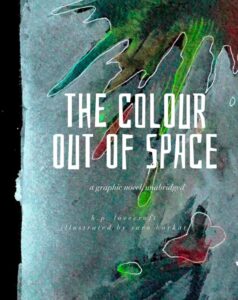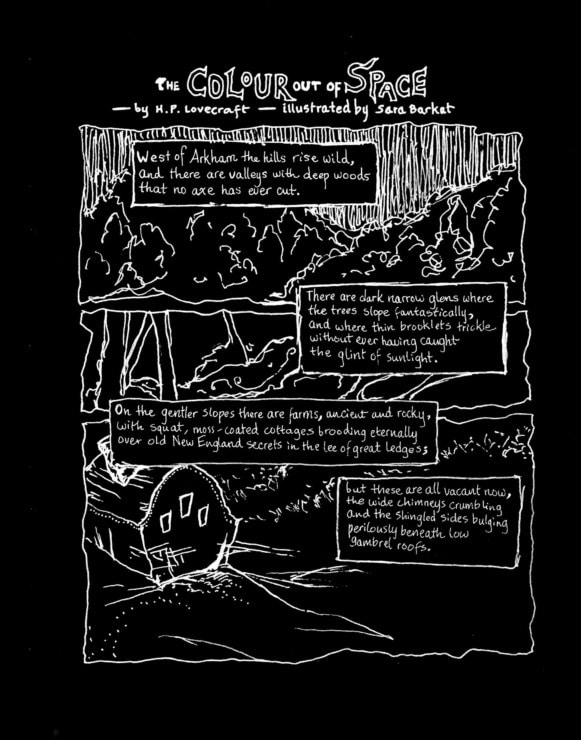Sara Barkat amplifies the impact of an H.P. Lovecraft classic
I’m a words guy. I’ve always been a words guy. Yep, I collected comic books, including Classics Illustrated, and I was an avid fan of Mad Magazine, the operating manual for adolescent boys from the 1950s to the 1970s. And, of course, there was television and movies. But still, I was a words guy – all through high school, studying journalism in college, and making a general career of words.
The arrival of audiobooks and graphic novels barely made a dent in my consciousness. Their fans are legion, but I was never among them, although I do enjoy my Kindle e-books (more words). But two things happening almost simultaneously pitched me headfirst into graphic novels. First, a friend recommended a new book on the friendship of C.S. Lewis and J.R.R. Tolkien called The Mythmakers. I ordered it because I implicitly trusted her judgment on books. When it arrived, I discovered it was a graphic novel, combined both non-fiction and informed fiction. Reluctantly, I read it. Enthusiastically, I read it right to the end. I was blown away.

And I was bowled over the second time by a graphic novel. That’s twice in less than a week.
Life may never be the same for the words guy.
Lovecraft’s story is, like most of Lovecraft’s work, strange bordering on the bizarre. First published in 1927, The Colour Out of Space begins straightforwardly enough. An engineer visits a farming area near the town of Arkham which will be submerged after construction of a dam. The area includes a desolate, barren wasteland, which was a thriving family farm half a century earlier. But no one will talk about what happened there, until an old-timer tells the story. And the story begins with a meteor, or something like it, falling to earth and landing in the farmer’s field.
Strange things begin to happen.
To say much more would give the story away, and it is something of a horror classic. I can say no extraterrestrials or space zombies go roaming the countryside. This is something original, and the slow pace at which it unfolds adds to the horror. Lovecraft was a master of this kind of story.
The words guy would have told you that you can’t improve upon a classic, and you shouldn’t think of trying. But Barkat’s edition of The Colour Out of Space takes the classic story and amplifies it in such as a way as to make you believe you’re experiencing something new, not a story published almost a century ago.

One indication of the effort Barkat put into this edition is that it’s 139 pages long. Every page is an illustration.
Barkat is the author-illustrator of recent editions of Robert Louis Stevenson’s The Strange Case of Dr. Jekyll and Mr. Hyde, Oscar Wilde’s The Picture of Dorian Gray, and Charlotte Perkins Gilman’s short story The Yellow Wall-Paper. She’s also published the children’s book The Midnight Ball, the Indie Excellence Awards finalist science fiction collection The Shivering Ground, and Earth Song, a collection of eco-poetry. She writes and illustrates The Sadbook Collections on Substack, and she’s served as editor for several books, including the popular The Teacher Diaries: Romeo & Juliet, The Joy of Poetry: How to Keep, Save & Make Your Life With Poems, and Twirl: My Life With Stories, Writing & Clothes.
I’m still a words guy, but Barkat’s edition of The Colour Out of Space has transformed me into an admirer of the graphic novel. When it’s done well, a graphic novel moves a story to a different level of reading experience altogether. And this one is done better than well.
Note: I read The Color Out of Space with the Kindle version. The print edition is also available for pre-order (and I’ve pre-ordered it; I’ve a suspicion that the printed version will be spectacular.)
Photo by Richard James, Creative Commons, via Flickr. Post by Glynn Young.
How to Read a Poem uses images like the mouse, the hive, the switch (from the Billy Collins poem)—to guide readers into new ways of understanding poems. Anthology included.
“I require all our incoming poetry students—in the MFA I direct—to buy and read this book.”
—Jeanetta Calhoun Mish
- Longfellow’s “Paul Revere’s Ride”: Creating a National Legend - April 17, 2025
- Poets and Poems: Katie Kalisz and “Flu Season” - April 15, 2025
- Poets and Poems: Michelle Ortega and “When You Ask Me, Why Paris?” - April 10, 2025



Leave a Reply